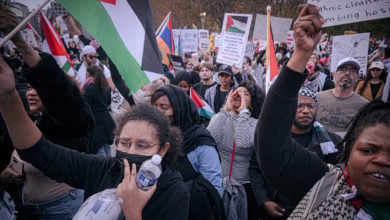Envision this: A foreign leader, say from Afghanistan, lands at Washington’s Dulles airport late at night, is whisked into a helicopter and lands unannounced a few minutes later on the White House lawn. President Obama is hurriedly rousted out of bed to meet his unanticipated guest.
 Obama and Karzai |
Hard to imagine? To put it mildly. For one thing, F-16 fighters would blast the hypothetical helicopter out of the sky before it could come close to touching down.
But this scenario—in reverse—is exactly what happened March 28 in Kabul, the capital of Afghanistan. Without informing Afghanistan’s U.S.-installed president, Hamid Karzai, that he was coming to call, Obama arrived near midnight at the country’s presidential palace. By the time Afghans woke up the next morning, he was on his way back to Washington.
Initial official explanations of “boosting troop morale,” or “surveying the situation on the ground,” did not mask for long the real purpose of the visit: to read Karzai the riot act.
Obama’s surprise visit highlighted the colonial character of the relationship between the United States and a client regime that it placed in office more than eight years ago. U.S. leaders neither trust their client to keep secrets nor consider him due the respect of advance notice.
Lately, however, the client has been showing signs of insubordination, endangering in Washington’s view the achievement of its core objectives in Afghanistan. Heightening the administration’s alarm is the fact that Karzai’s recent rebelliousness comes in the midst of a major campaign to rally popular support here for the major buildup of U.S. forces there.
The U.S. military is engaging in a rapid escalation in the number of troops, which will bring the total deployment of forces to 98,000 by summer. Tens of thousands of soldiers from other NATO countries and more than 100,000 private “contractors” are already in the country. The aim is to crush a growing resistance movement and firmly establish U.S. dominance of the region.
Sequence of conflict
Karzai was inaugurated for a new term in November 2009, following an election marked—as all sides have agreed—by massive voter fraud. Like most colonial governments, the Karzai regime has been characterized by endemic corruption. It is reportedly impossible for Afghanis to obtain government services at any level without paying bribes.
Under intense U.S. pressure, Karzai called for anti-corruption steps in his inaugural speech. Then, in early March of this year, Karzai announced a decree allowing the president to appoint the five members of the election commission overseeing the parliamentary election set for September. Presently, the United Nations—in another clear sign of the colonial reality—appoints three of the commission’s five members.
Like a parent punishing a disobedient child, the White House reacted by canceling Karzai’s scheduled visit to Washington and his meeting with Obama. The administration was shocked by what came next.
On March 10, Iranian Pesident Mahmoud Ahmadinejad arrived in Kabul at Karzai’s invitation. At a press conference with Karzai standing at this side, Ahmadinejad condemned the U.S. drive for new sanctions against Iran and control of the Middle East and Central Asia. He also accused the United States of promoting terrorism in the region.
Later in March, Karzai traveled to Iran’s capital, Tehran, and joined a celebration of Nowruz, the traditional Persian New Year holiday .
While what was said in their unscheduled meeting has remained secret up until now, there is no doubt that Obama’s aim was to whip Karzai into line. The next day, the capitalist “newspaper of record,” the New York Times, editorialized that Obama’s visit was “a long overdue and desperately needed attempt to persuade President Hamid Karzai to clean up his act.”
But just days later, Karzai made a highly publicized speech attacking “the West and the United Nations,” saying: “They wanted to have a puppet government. They wanted a servant government .” In classic understatement, a senior U.S. government figure told the Times that Karzai’s speech was “not necessarily what we expected ” just five days after Obama’s visit.
The client and the master
The U.S. leaders’ problem is that while they have little confidence in Karzai, the collapse of his government could bring even greater loss of control as they seek to subdue Afghanistan. This undoubtedly informs Karzai’s increasingly defiant stand, as does the growing opposition of the Afghan people to seemingly endless imperialist occupation.
When the empire appears invincible, no client dares to defy its will. When it seems weak and unable to implement its full agenda, then even clients start doing things that demonstrate their lack of full confidence in its strength.
Karzai is a client only because he sees the survival of his regime and the class interests he represents dependent on imperialist support. His defiance is really an indication of U.S. weakness, and his perception that he must have good relations with Iran, Afghanistan’s relatively powerful neighbor, even if this means upsetting the United States.






